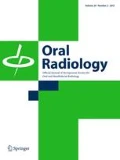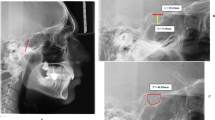Abstract
Objectives
The sella turcica is an important component situated in the mid-third of the cranial fossa. Knowledge about its normal morphologies and dimensions may play a crucial role in diagnosing underlying pathologies. The present study aimed to analyze the principal morphological shapes of the sella turcica, measure its linear dimensions, and determine whether any correlations exist between its dimensions and body mass index (BMI) in subjects in a North Indian population.
Methods
The study was conducted on 100 subjects (50 men; 50 women) who underwent cone-beam computed tomography scans at our Oral Medicine and Radiology Department. The subjects had an age range of 20–60 years. The morphology of the sella turcica was examined according to age and various measurements were taken to determine its size. Possible correlations between the dimensions of the sella turcica and BMI were evaluated by statistical analysis.
Results
In the present study, 69% of the subjects had a normal morphology. No uniform increases in length, width, and depth of the sella turcica were observed with aging. When Pearson correlation coefficients were calculated, no strong correlations were found between the dimensions of the sella turcica and BMI. A mild correlation was seen between the length and width of the sella turcica.
Conclusion
No significant correlations were found between the dimensions of the sella turcica and BMI in the present study. These findings may have arisen through the small sample size, and thus further studies with larger groups of subjects are warranted.


Similar content being viewed by others
References
Tekiner H, Acer N, Kelestimur F. Sella turcica: an anatomical, endocrinological, and historical perspective. Pituitary. 2015;18:575–8.
Kolagi S, Herur A, Patil G, Rairam GB. Complete sella turcica bridges prevalence and dimensions. J Anat Soc India. 2011;60:22–5.
Jones RM, Faqir A, Millett DT, Moos KF, McHugh S. Bridging and dimensions of sella turcica in subjects treated by surgical-orthodontic means or orthodontics only. Angle Orthod. 2005;75:714–8.
Pisaneschi M, Kapoor G. Imaging the sella and parasellar region. Neuroimaging Clin N Am. 2005;15:203–19.
Chauhan P, Kalra S, Mongia SM, Ali S, Anurag A. Morphometric analysis of sella turcica in North Indian population: a radiological study. Int J Res Med Sci. 2014;2:521–6.
Anandhi KS, Kumar AS, Kumari MCI. Abnormal small sella—a case report. J Anat Soc India. 2009;58:13–5.
Keleştimur F. Sheehan’s syndrome. Pituitary. 2003;6:181–8.
Kiran CS, Ramaswamy P, Santosh N, Smitha B, Satish A. Radio-morphometric analysis of sella turcica in the South Indian Population: a digital cephalometric study. Arab J Forensic Sci Forensic Med. 2017:517–23.
Norton LA, Melsen B. Functional appliances. In: Melsen B, editor. Current controversies in orthodontics. Chicago: Quintessence Publishing; 1991. pp. 103–30.
Chen JK, Tang JF, Du LS, Li H. Radiologic analysis of 540 normal Chinese sella turcica. Chin Med J (Engl). 1986;99:479–84.
Lang J. Structure and postnatal organization of heretofore uninvestigated and infrequent ossifications of the sella turcica region. Acta Anat (Basel). 1977;99:121–39.
Gordon MB, Bell AL. A roentgenographic study of the sella turcica in normal children. N Y State J Med. 1922;22:54–9.
Axelsson S, Storhaug K, Kjær I. Post-natal size and morphology of the sella turcica. Longitudinal cephalometric standards for Norwegians between 6 and 21 years of age. Eur J Orthod. 2004;26:597–604.
Alkofide EA. The shape and size of the sella turcica in skeletal class I, class II and class III Saudi subjects. Eur J Orthod. 2007;29:457–63.
Shah AM, Bashir U, Ilyas T. The shape and size of the sella turcica in skeletal class I, II, and III in patients presenting at Islamic International Dental Hospital, Islamabad. Pak Oral Dent J. 2011;31:104–10.
Nagaraj T, et al. The size and morphology of sella turcica: a lateral cephalometric study. J Med Radiol Pathol Surg. 2015;1:3–7.
Silverman FN. Roentgen standards fo-size of the pituitary fossa from infancy through adolescence. Am J Roentgenol Radium Ther Nucl Med. 1957;78:451–60.
Quaknine GE, Hardy J. Microsurgical anatomy of the pituitary gland and the pituitary gland and the sellar region. 1. The pituitary gland. Am Surg. 1987;53:285–90.
Choi WJ, Hwang EH, Lee SE. The study of shape and size of normal sella turcica in cephalometric radiographs. Korean J Oral Maxillofac Radiol. 2001;31:43–9.
Israel H. Continuing growth in sella turcica with age. Am J Roentgenol Radium Ther Nuclear Med. 1970;108:516–27.
Author information
Authors and Affiliations
Corresponding author
Ethics declarations
Conflict of interest
Vidisha Gargi, Sasankoti Mohan Ravi Prakash, K. Nagaraju, Sangeeta Malik, Sumit Goel, and Swati Gupta declare that they have no conflict of interest.
Human rights statement and informed consent
All procedures followed were in accordance with the ethical standards of the responsible committee on human experimentation (institutional and national) and with the Helsinki Declaration of 1964 and later versions. Informed consent was obtained from all patients for being included in the study.
Rights and permissions
About this article
Cite this article
Gargi, V., Ravi Prakash, S.M., Nagaraju, K. et al. Radiological analysis of the sella turcica and its correlations with body mass index in a North Indian population. Oral Radiol 35, 184–188 (2019). https://doi.org/10.1007/s11282-018-0337-9
Received:
Accepted:
Published:
Issue Date:
DOI: https://doi.org/10.1007/s11282-018-0337-9




